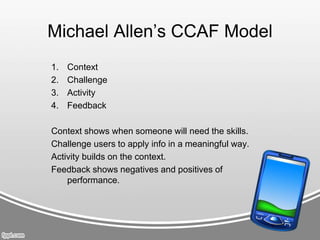Mlearning instructional design
- 1. mobile learning instructional design Neil Davie mlearning, Summer semester 2014
- 2. What is instructional design? The practice of creating ŌĆ×ŌĆ”instructional experiences which make the acquisition of knowledge and skill more efficient, effective, and appealing.ŌĆØ Merrill et al, 1996. Broadly speaking covers 3 stages: 1. Learner needs analysis. 2. Defining goals. 3. Training intervention.
- 4. ThiagiŌĆÖs 4-door Model Offers four entry points into a course: 1. The library. 2. The playground. 3. The cafe. 4. The assessment centre. Learners can enter through any door they choose.
- 5. Cathy MooreŌĆÖs Action Mapping Process Focuses on what people need to do rather than what someone thinks they need to know: 4 stages: 1. Identify the business goal. 2. Identify what people need to meet it. 3. Design activities to help practice. 4. Identify minimum information required.
- 6. Michael AllenŌĆÖs CCAF Model 1. Context 2. Challenge 3. Activity 4. Feedback Context shows when someone will need the skills. Challenge users to apply info in a meaningful way. Activity builds on the context. Feedback shows negatives and positives of performance.
- 7. Instructional design & me 1. How can I use these models? 2. How will they help me design my project? 3. How will they enhance the learnerŌĆÖs experience? 4. How will they save me time and effort? Ask yourself these questions before you begin.







